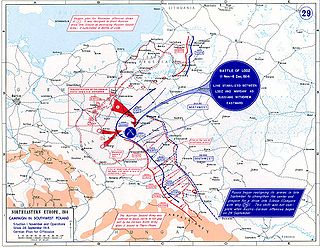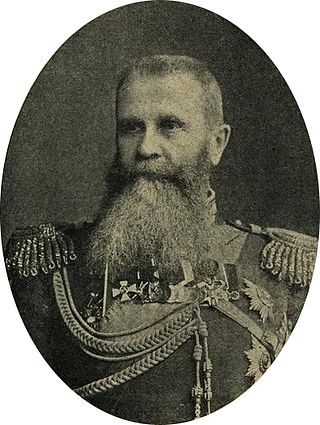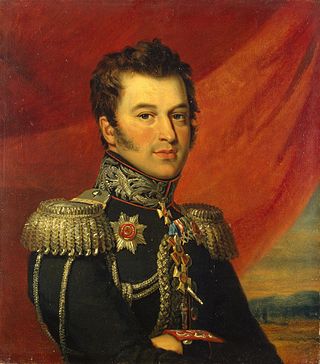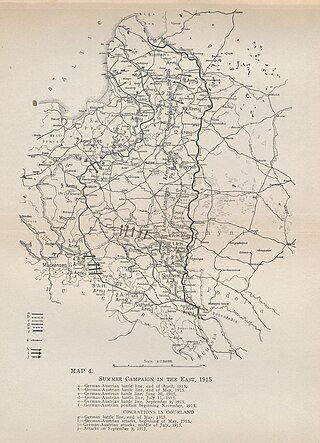History
The command-in-chief of the First West Army on March 19 (April 2) 1812 was assigned to General of the Infantry M. B. Barklay de Tolli. However, after arriving 14 (26) April 1812 in Vilno at the general headquarters of the First West Army, the Emperor Alexander I became both legally and actually its commander-in-chief, since according to §18 of "Establishments for management of the large acting army”, introduced on January 27 (8) February 1812, “the presence of Emperor represents the main command authority of the army, unless when specified by an order, the acting commander-in-chief is directed to retain complete authority”. There was no such order, therefore, the Emperor assumed command of the army. When on the 7 (19) July 1812 the Emperor left the field army, M. B. Barklay de Tolli again became its commander-in-chief. [1]

Prince Michael Andreas Barclay de Tolly was a Russian Field Marshal who figured prominently in the Napoleonic Wars.

The Battle of the Vistula River, also known as the Battle of Warsaw, was a Russian victory against the German Empire and Austria-Hungary on the Eastern Front during the First World War.

The First Battle of the Masurian Lakes was a German offensive in the Eastern Front 2–16 September 1914, during the Russian invasion of East Prussia. It took place only days after the Battle of Tannenberg where the German Eighth Army encircled and destroyed the Russian Second Army. Using the rapid movements aided by the East Prussian railway network, the Eighth Army reformed in front of the spread-out Russian First Army and pushed them back across their entire front, eventually ejecting it from Germany. Further progress was hampered by the arrival of the Russian Tenth Army on the Germans' right flank.

Yefim Ignatyevich Chaplits/Tschaplitz, born Eufemiusz Czaplic, was a Polish military commander in the service of the Russian Empire.

Nikolai Iudovich Ivanov was a Russian artillery general in the Imperial Russian Army. In July 1914, Ivanov was given command of four armies in the Southwestern Front against the Austro-Hungarian army. During the Russian Revolution of March 1917, Tsar Nicholas II ordered Ivanov to suppress the revolutionaries but as promised reinforcements failed to come to his aid, he canceled the aborted mission. In 1917, he retired but a year later took command of the White Army. In 1919, Ivanov died of typhus in Southern Russia.
The Imperial Russian Army in June 1812 consisted of three main armies and other military formations. The Commander in Chief of the Army was Emperor Alexander I.
This is the German Army order of battle on the outbreak of World War I in August 1914.

The Imperial Russian Army or Russian Imperial Army was the armed land force of the Russian Empire, active from 1721 until the Russian Revolution of 1917. It was organized into a standing army and a state militia. The standing army consisted of regular troops and two forces that served on separate regulations: the Cossack troops and the Muslim troops.

Vladimir Viktorovich Sakharov was a Russian general of the cavalry who served in the Russian Imperial Army. In an army career lasting from 1869 to 1917, he served in the Russo-Turkish War of 1877-1878, the Russo-Japanese War, and World War I.
The Second Western Army was created during 1810 as part of the reform of the Imperial Russian Army as a whole and was intended to defend the central western region of the Russian border with Poland to the Austrian border during the expected French invasion of Russia.
The Third Reserve Army of Observation was a Russian army created during 1811 as an impromptu force to watch the Austrian frontier when it became apparent that the Austrian Emperor would possibly send troops into Russia as part of the French invasion of Russia. It had 44,000 men and 168 guns. Alexander Tormasov took command of the army on 27 March 1812. It was renamed the Third Western Army on 30 September 1812 following its merger with the Army of the Danube. The Third Western Army, led by Pavel Chichagov, failed to cut off Napoleon's army's retreat, though it followed the French into Poland the following January.
The Army of the Danube was a field army of the Russian Empire, created for the Russo-Turkish War of 1806–1812.

This is the order of battle of the French invasion of Russia.
The following units of the British, French and German Empires fought in the First Battle of the Marne from 5–12 September 1914 on the Western Front of World War I.
The following Union Army units and commanders were the initial structure on April 4, 1862 of the Union Department of the Potomac during the Peninsula campaign of the American Civil War. This list includes units deployed to the Virginia Peninsula, and those that remained in the Washington area. The Confederate order of battle is listed separately.

Paisi Sergeevich Kaysarov was a Russian general who served during the Napoleonic Wars.
Aleksey Domantovich was a Russian general and the commander of the Persian Cossack Brigade.

Samad bey Rafibeyli Azerbaijani and Turkish military leader, lieutenant colonel of the Azerbaijan Democratic Republic, major general (1948) of the Turkish Republic. The first Azerbaijani to reach the rank of general in the Turkish Armed Forces, where he is known under the name Sayqin.

His Majesty's Life Guards Hussar Regiment was a Guards Hussar regiment of the Army of the Russian Empire.

First Riga offensive was a military operation of the German Imperial Army with to divert Russian forces from the direction of the main blow of the German summer offensive on Narew River. The Germans broke through the heavily fortified defenses of the Russian army and defeated the vastly superior enemy forces. However, no decisive success was achieved, and at the beginning of August the Russians launched a counteroffensive.
This page is based on this
Wikipedia article Text is available under the
CC BY-SA 4.0 license; additional terms may apply.
Images, videos and audio are available under their respective licenses.











